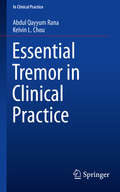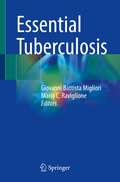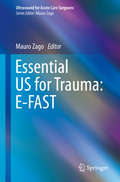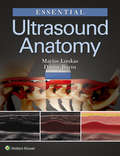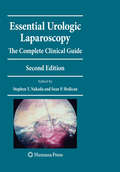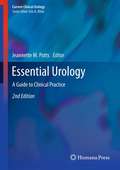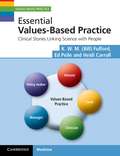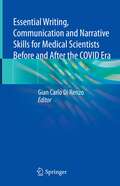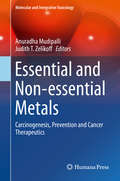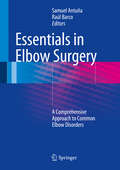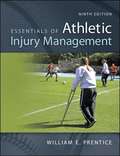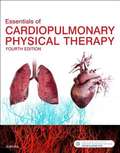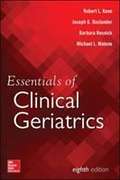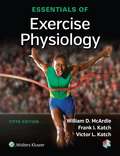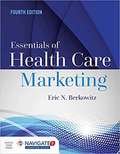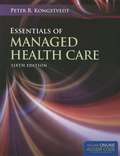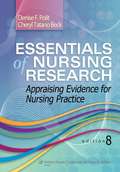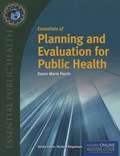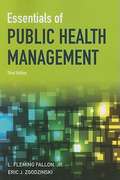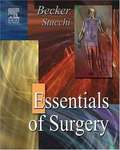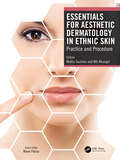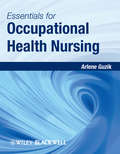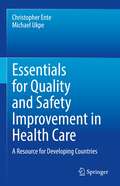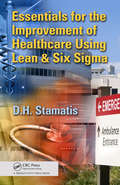- Table View
- List View
Essential Tremor in Clinical Practice
by Abdul Qayyum Rana Kelvin L. ChouThis practical, concise guide discusses how to distinguish different types of tremor and make the diagnosis of essential tremor. Written in an easy-to-read format, this book summarises other conditions that may be confused with essential tremor and details all current treatment options for this condition, including medications, surgery and non-invasive alternatives. Examination techniques for patients with a tremor complaint are described, some of which may be novel to the general practitioner, and case studies full of diagnostic and examination pearls are provided. Essential Tremor in Clinical Practice is an updated version of Abdul Qayyum Rana's previous book, An Introduction to Essential Tremor. Busy clinicians, including internists, general and family practitioners, and geriatricians will benefit from this short yet comprehensive, clinically focussed volume.
Essential Tuberculosis
by Mario C. Raviglione Giovanni Battista MiglioriThis textbook covers the full spectrum of tuberculosis-related topics in a comprehensive yet easy-to-follow, readily accessible format. Filling a significant gap in tuberculosis literature, it addresses tuberculosis sensu latu, mirroring the content of the London Queen Mary University tuberculosis Diploma.Covering all aspects related to this condition, from prevention, diagnosis and treatment to public and global health, the book provides a broad overview of tuberculosis management. Further, it includes a wealth of case studies and exercises, making it an essential guide for all staff involved in tuberculosis management. Written by an international and interdisciplinary panel of experts, the book appeals to a broad readership including students, postdoctoral fellows, clinicians, researchers, and nurses, as well as public health officers working in tuberculosis control programs.
Essential US for Trauma: E-FAST
by Mauro ZagoE-FAST (extended focused assessment by sonograpy for trauma) represents the basic ultrasonographic approach to any trauma patient. Identification or exclusion of free fluid and air in the abdominal and thoracic cavities plays a pivotal role in deciding the immediate diagnostic and therapeutic path. Learning E-FAST is mandatory for all acute care surgeons and all physicians involved in trauma management. The structure of the book and its practical approach will make it an easy-to-consult and quick reference tool for beginners and a useful support for more experienced professionals.
Essential Ultrasound Anatomy
by Marios Loukas Danny BurnsPresenting sonography in the context of anatomy and clinical practice, Essential Ultrasound Anatomy offers practical, comprehensive coverage of the ultrasound images and important structures that are most frequently encountered in daily practice. Using concise text, ultrasound images with corresponding cadaver photographs, full-color anatomical and technique illustrations, and videos, it provides today’s students with a solid foundation in regional ultrasound anatomy.
Essential Urologic Laparoscopy
by Stephen Y. Nakada Sean HedicanIn Essential Urologic Laparoscopy: The Complete Clinical Guide, Second Edition, editors Sean P. Hedican and Stephen Y. Nakada provide a complete update of their critically acclaimed first edition while adding new material related to Hand Assisted Laparoscopic Radical Cystectomy, Laparoscopic Retroperitoneal Lymph Node Dissection and Laparoscopic Assisted Renal Ablation. The authors offer clear, concise chapters focusing on getting started, laparoscopic instrumentation, and step-by-step procedural adult laparoscopy. Each chapter is organized so that the reader can easily identify key points and pitfalls, providing user-friendly text that describes the essential equipment necessary for performing urologic laparoscopy. Authorative and highly practical, Essential Urologic Laparoscopy: The Complete Clinical Guide, Second Edition provides a comprehensive guide to performing effective and cutting-edge urologic laparoscopy and is a must have for any urologist looking to create, maintain, or expand a successful practice in minimally invasive urologic surgery.
Essential Urology
by Jeannette M. PottsExtensively revised and updated, the second edition of Essential Urology: A Guide to Clinical Practice provides support to primary care physicians through its review of common genitourinary problems. This edition continues to provide the primary care physician with tools to better recognize urological diseases as well as updated management strategies for these disorders. To enhance the theme of comprehensive care and family medicine, the volume is formatted according to the life cycle and the urological challenges, which may be detected and diagnosed by primary care physicians respective of the patient's stage in life, beginning with pregnancy and in utero diagnoses. Pediatric themes such as infection and voiding dysfunctions are followed by adult urological topics ranging from prostate diseases, nephrolithiasis, overactive bladder syndromes, incontinence and urological cancer screening. Three new chapters are added addressing male infertility/andrology and the growing demand for integrative and alternative medical care of urologic patients, as well as commonly encountered dermatological problems in the genital area. Essential Urology: A Guide to Clinical Practice, Second Edition is extremely comprehensive and yet, very accessible. It is authored by experts representing the spectrum of urological subspecialties, further enhancing the value of this unique work.
Essential Values-Based Practice
by Ed Peile Heidi Carroll K. W. FulfordThis book will help clinicians acquire and develop the processes and skills of values-based practice. The aim of most patient-clinician consultations is to improve health outcomes. Often they succeed, and patients are satisfied and empowered. However, some consultations are unsatisfactory and result in failure to improve health outcomes and dissatisfaction on the part of patients, carers or clinicians. When consultations fail to achieve the desired results, the cause is not usually a failure of evidence-based practice. Today's clinicians are trained in evidence-based medicine, educated, updated and appraised. The most likely reason why things go wrong is a failure of values-based practice - not ascertaining the relevant values perspectives and acting on them in a coherent and purposeful manner. If you rehearse and practise the elements of values-based practice detailed in this book, you will find your consultations more personally rewarding and your patients are likely to derive more benefit.
Essential Writing, Communication and Narrative Skills for Medical Scientists Before and After the COVID Era
by Gian Carlo Di RenzoWhen the COVID- 19 pandemic occurred, all the main communication systems of medical research have undergone an epochal change. Many online journals and magazines have tried to publish inherent works of this specific problem as soon as possible, soliciting and preferring them to others, thus changing the system of free acceptance of scientific works once. Moreover, the way to communicate these works has no longer occurred through standard Scientific Congresses but with other systems, websites/streaming and webinars or virtual conferences. Now there is something systematic missing, which foresees that this may last in the future, in the post COVID-19 era (AC): the communication system of the medical sciences will be different from now on. There will be far fewer classical-style conferences like the ones so popular before COVID-19 outbreak (BC) but there will be more webinars, in streaming and virtual conferences. This new book fits well in this period, creating a bridge between those who do research, how it is communicated, what are the classic communication methods and what is all the necessary background to communicate with new tools. The book idea is based on the legacy left by Michael Faraday, the famous American chemist, who sensed how communicating what happens in science can make the difference between the success and failure of the research itself: “A lecturer should appear easy and collected, undaunted and unconcerned” “Lecturers which really teach will never be popular; lecturers which are popular will never really teach “ Michael Faraday, "Advice to lecturers", 1848 The volume approach is multidisciplinary and written by top experts in the field of communication and education. It will be a useful tool for scientists in this moment of epochal change in medical communication.
Essential and Non-essential Metals
by Anuradha Mudipalli Judith T. ZelikoffThis book aims to present current state of understanding of the role of metals in human health and disease. As it will be difficult to cover all of the metals, about two scores of them, the authors will instead provide a detailed analysis of a select set of essential (Calcium, Magnesium, Selenium, Iron, copper and Zinc) and non-essential metals (Nickel, Chromium, Cadmium and Arsenic, Tungsten and Asbestos). Each chapter will have a dedicated section focusing on the binary role that some of these metals play, their carcinogenic and cancer therapeutics, by integrating epidemiological, experimental evidence with special emphasis and focus on molecular mechanisms involved in these processes. The biological analysis will also include emerging lines of evidence such as micro RNAS, kinase families, receptors, endoplasmic, mitochondrial players and epigenetics. As part of integrating the human, experimental and mechanistic data, as well as a detailed analysis into the modes of action for different cancer outcomes will be discussed in each chapter wherever deemed feasible. These approaches are ones in which no other book in this area has attempted to do.
Essentials In Elbow Surgery
by Samuel Antuña Raúl BarcoThe idea of this book is very simple. Nowadays, there are many good, very comprehensive, "thick" books available on Elbow Surgery. Although they are useful to obtain discrete information about specific topics, they are too large to be a user friendly for a general orthopedic surgeon facing common elbow problems. The increasing interest among young surgeons on elbow problems is remarkable. It has been our experience throughout the years, teaching our residents and visitors, that there is a real demand for a less extensive book, easy to read, and with practical information about the most commonly encountered problems of the elbow. This text would be enough to understand the common elbow practice for a general orthopedic surgeon and a guide to learn basic elbow surgery during training. There is nothing like this available today. It will be strongly oriented to practice, and all the authors, well known internationally for their expertise on elbow surgery, will be homogeneous in their message.
Essentials Of Athletic Injury Management
by William E. Prentice Daniel D. ArnheimEssentials of Athletic Injury Management is written at a level more appropriate for the coach, fitness professional, and physical educator. It provides guidance, suggestions, and recommendations for handling athletic health care situations when an athletic trainer or physician is not available.
Essentials Of Cardiopulmonary Physical Therapy (Fourth Edition)
by Ellen HillegassImprove your understanding of the cardiopulmonary system with Essentials of Cardiopulmonary Physical Therapy, 4th Edition. Based on best practices prescribed in The Guide to Physical Therapist Practice, this new edition provides comprehensive coverage of anatomy, physiology, and cardiopulmonary assessment, along with expanded chapters on the growing topics of early mobilization of the ICU patient and acute care management. Using a practical approach, expert author Ellen Hillegass also discusses pathophysiology, pharmacology, and interventions in the outpatient setting. <p><p> Evidence-based content reflects the latest research in the field and incorporates the use of ICF. Material uses best practices defined by the American Physical Therapy Association. Clinical tips give you real-world hints and suggestions from practicing clinicians. <p> NEW! Expanded chapters cover early mobilization of the ICU patient and acute care management. <p> NEW! Updated references emphasize evidence-based information from the text. <p> NEW! Full-color printing enhances text.
Essentials Of Clinical Geriatrics
by Robert L. Kane Barbara Resnick Michael L. Malone Joseph G. OuslanderEssentials of Clinical Geriatrics is an engagingly written, up-to-date introductory guide to the core topics in geriatric medicine. Since 1984, its goal has remained unchanged: to help clinicians do a better job of caring for their older patients. You will find thorough and authoritative coverage of all the important issues in geriatrics, along with concise, practical guidance on the diagnosis and treatment of the diseases and disorders most commonly encountered in an elderly patient. <P><P> Presented in full-color, this classic features a strong focus on the field’s must-know concepts, from the nature of clinical aging to differential diagnosis of important geriatric syndromes to drug therapy and health services. The Eighth Edition has been completely revised to provide the most current updates on the assessment and management of geriatric care. <P><P> FEATURES: • Numerous tables and figures that summarize conditions, values, mechanisms, therapeutics, and more • Thorough coverage of preventive services and disease screening • Eight chapters devoted to general management strategies • Important chapters on ethical issues and palliative care • Appendix of Internet resources on geriatrics <P><P> Essentials of Clinical Geriatrics, Eighth Edition is the best resource available to help healthcare professionals provide the innovative, cost-effective, and person-centered care that older people and their caregivers deserve.
Essentials Of Exercise Physiology
by William D. Mcardle Frank I. Katch Victor L. KatchHelp your students succeed in the course and their future careers with this Fifth Edition of the briefer version of the best-selling McArdle Exercise Physiology text. The book emphasizes nutrition as the foundation of exercise and uses a new student-friendly magazine-style design, hallmark pedagogy, and an engaging writing style to make exercise physiology interesting and understandable for today's undergraduate students. Featuring updates in every section that reflect the latest trends and research in the field, Essentials of Exercise Physiology helps students develop a deep understanding of the interrelationships among energy intake, energy transfer during exercise, and the related physiologic systems. As they progress through the book, students also master the how-tos of applying key concepts to enhance exercise training, athletic performance, and health. In addition, the Fifth Edition includes a suite of instructor and student resources designed to save you time and help your students succeed. Student Resources: An online Interactive Question Bank with study and quiz options helps students master the content of the course. Supplemental documentation relevant to the field includes The Internet and Exercise Physiology, Surgeon General's Vision for Health Fit Nation 2010, and a Guide to Reliable Supplemental Information Sources. A list of Frequently Cited Journals in Exercise Physiology enables students to increase their understanding of topics of interest. Animations of key exercise physiology concepts selected by reviewers help students understand complex processes. Instructor Resources: PowerPoint presentations make it easy to integrate the textbook with your students' classroom experience via either handouts or slide shows. A complete image bank enhances lecture and exam preparation. A robust test generator helps you put together tests that assess your students' understanding.
Essentials Of Health Care Marketing
by Eric N. BerkowitzNew Fifth Edition of Essentials of Health Care Marketing coming in March 2021. The healthcare industry continues to undergo enormous changes with new laws and policies, fresh innovations, and an increasingly educated health consumer. As such, healthcare administrators must be prepared to shift their strategies in order to meet the demands of this dynamic market. Essentials of Health Care Marketing, Fourth Edition will provide your students with a foundational knowledge of the principles of marketing and their particular application in health care. Moreover, the text offers a perspective on how these principles must shift in response to the changing environmental forces that are unique to this market. This complete curriculum of marketing management tools and techniques is ideal for graduate courses, though advanced undergraduates can readily grasp the level of presentation. New to the Fourth Edition: Chapter 3 (Environment) heavily revised to include new health care delivery models, increased competition, foreign competitors, and health care reform. Chapter 4 now includes discussion of exchanges. Chapter 10 addresses increasing amount of system consolidation.
Essentials Of Managed Health Care (Sixth Edition)
by Peter R. KongstvedtAs the most widely-used textbook on managed care, Essentials of Managed Health Care provides an authoritative and comprehensive overview of the key strategic, tactical, and operational aspects of managed health care and health insurance. With a primary focus on the commercial sector, the book also addresses managed health care in Medicare, Medicaid, and military medical care. An historical overview and a discussion of taxonomy and functional differences between different forms of managed health care provide the framework for the operational aspects of the industry as well. The Sixth Edition is a thorough revision that addresses the impact of HR 3590, the Patient Protection and Affordable Care Act, as well as other new laws such as the Genetic Information Non-disclosure Act (GINA).
Essentials Of Micro- and Nanofluidics: With Applications to the Biological and Chemical Sciences
by A. Terrence ConliskThis textbook introduces students to the basic physical principles to analyse fluid flow in micro- and nano-size devices. This is the first book that unifies the thermal sciences with electrostatics and electrokinetics and colloid science; electrochemistry; and molecular biology. Key concepts and principles are discussed, such as the essentials of viscous flows, introductory electrochemistry, heat and mass transfer phenomena, elements of molecular and cell biology and much more. State-of-the-art analytical and computational approaches to problems in all of these areas are presented, especially electrokinetic flows, and examples are given of the use of these approaches to design devices used for rapid molecular analysis, biochemical sensing, drug delivery, DNA analysis, the design of an artificial kidney and other transport phenomena. There are exercise problems and modern examples of applications, as well as a solutions manual available for qualified instructors.
Essentials Of Nursing Research: Appraising Evidence For Nursing Practice
by Denise F. Polit Cheryl Tatano BeckNew to this edition: - New text organization with separate sections on quantitative and qualitative research offer greater continuity of ideas to better meet the needs of students and faculty. - New online chapter supplements for every chapter expand student's knowledge of research topics. - New chapter on mixed methods research, which involves the blending of qualitative and quantitative data in a single inquiry, responds to the surge of interest in this type of research - Increased emphasis on evidence-based practice (EBP) especially in the areas of asking well-worded questions for EBP and searching for such evidence guides the reader from theory to application. - Enhanced assistance for instructors with numerous suggestions on how to make learning about--and teaching--research methods more rewarding.
Essentials Of Planning And Evaluation For Public Health (G - Reference, Information And Interdisciplinary Subjects Ser.)
by Karen PerrinFilled with cases and examples from across the spectrum of Public Health specialties, Essentials of Planning and Evaluation for Public Health provides a basic understanding of the importance of and the key approaches used to conduct and evaluate effective public health programs. Organized in a step-by-step process, the chapters provide an accessible and engaging overview of topics needed to review published literature, collect primary data, analyze data using basic statistics, and present results in written or verbal formats for their intended audiences. Examples and case studies are woven throughout, from a broad array of public health applications such as global health, environmental health, community health, and social science. Key Features: * Offers a clear, easy-to-read foundational overview of the process of Public Health program evaluation * Includes an easy explication of basic statistics using Microsoft Excel * Uses many examples and cases specific to the field of Public Health * Authored by an award-winning Professor in undergraduate public health studies Instructor Resources: Instructor's Manual, PowerPoint slides, TestBank
Essentials Of Public Health Management
by L. Fleming Fallon Eric J. ZgodzinskiFeaturing new expert contributing authors from across the country, this timely revision addresses all the important topics in the effective management of public health departments and agencies. Using a practical, nontheoretical approach, the book is ideal for the hands-on management of these complex organizations and their daily operations. The Third Edition has been thoroughly revised with new case studies as well as the following new chapters: • Chapter 2 Leadership and Governance • Chapter 16 Public Health Performance Standards • Chapter 17 Continuous Quality Improvement • Chapter 18 Accreditation • Chapter 21 Social (Electronic) Media • Chapter 28 Starting a Health Board in the 21st Century The text is accompanied by a complete package of instructor resources including a Transition Guide, Instructor's Manual, TestBank, and PowerPoint slides.
Essentials Of Surgery
by James M. Becker Arthur F. StucchiEssentials of Surgery efficiently delivers the knowledge you need to succeed in medical school and surgical residencies. More than 80 respected academic surgeons from leading institutions across the United States synthesize the most important information from the field. Essentials of Surgery will get you through this complex and dynamic specialty - expertise you'll turn to for years to come. Zeroes in on the hands-on know-how necessary to diagnose and manage the full range of surgical diseases, including only the minimum basic science needed to meet these clinical challenges. Considers surgery within the full armamentarium of therapeutic options, not simply as the sole route for treatment. Emphasizes minimally-invasive surgery, ambulatory surgery and new surgical technologies to reflect the realities of today's practice. Uses "Pearls for the OR" and "Pearls for Rounds" to convey key information at a glance. Includes hundreds of original full-color illustrations to make concepts clear. Includes one-year access to Sabiston Textbook of Surgery, 17th edition. Includes access to www. studentconsult. com - where you'll find the complete text and illustrations of the book online, fully searchable #65533; "Integration Links" to bonus content in other STUDENT CONSULT titles #65533; video clips of common surgical procedures #65533; content clipping for handheld devices #65533; an interactive community center with a wealth of additional resources #65533; and much more!
Essentials for Aesthetic Dermatology in Ethnic Skin: Practice and Procedure
by Mukta Sachdev Niti Khunger Ninon PatraoThis book focuses on creating awareness and detailing the nuances of aesthetic dermatology practice in skin of color. It highlights practical considerations in pre-/intra-/post-procedure care with an emphasis on patient selection for aesthetic procedures and the associated challenges involved in real-time practice. It aims to cater to audiences of countries with both high and low populations of dark-skinned patients, as clinicians often have limited experience in treating this group. Numerous topics are explored through case-based discussions and practical tips. This is a practical ready reference manual for a cosmetic dermatologist dealing with darker skin. Key Features Covers the geo-ethnic skin types of Asians, Southeast Asians, Africans, and Hispanics Explores the topics through case-based discussions Provides comprehensive details about the use of machines on skin of color
Essentials for Occupational Health Nursing
by Arlene GuzikThe scope of occupational health nursing practice has expanded and taken on a variety of roles, giving rise to opportunities for nurses to care for workers in various workplace settings. Essentials for Occupational Health Nursing provides a highly practical and accessible guide for nurses entering or already engaged in this important field. The text begins with the foundations for occupational health practice, covering the domain of occupational health and the role of the many professionals within the specialty. Subsequent chapters address program development, professional development, workplace regulatory requirements, workplace injury management and managing health and productivity. Case studies pertaining to fitness for duty and medical monitoring provide real-life scenarios to aid in learning.
Essentials for Quality and Safety Improvement in Health Care: A Resource for Developing Countries
by Christopher Ente Michael UkpePatient safety and quality improvement in health care remain a global priority. Subpar performance in health care, however, is still common more than a decade after the christening of patient safety in Africa. The core principle of safety and quality improvement systems is to identify and assess the root cause of failures in order to learn from them and devise a means to improve and to avoid recurrence. This book is designed to encourage, facilitate and empower healthcare workers in the development and implementation of strategically driven patient safety and quality improvement initiatives for safer healthcare systems and healthcare facilities in low- and middle-income countries (LMICs) of Africa. It also highlights some of the profound challenges and barriers to designing and implementing patient safety and quality improvement interventions or programmes in the region and reiterates the need to remain focused and determined to work out solutions with confidence and overcome these barriers. In the book, chapters highlight six essential components crucial for achieving evolutionary progress in safety and quality improvement in a healthcare system: Standard operating procedureAuditResearchSafety managementQuality managementEvaluationPractical steps in planning and conducting these six essential components are outlined with some specific features to aid learning and facilitate their implementation. The authors have experience and expertise in the medical practice gained in Africa and a decade of knowledge and experience from consultancy work in safety and quality improvement in health care within and outside the region. Essentials for Quality and Safety Improvement in Health Care: A Resource for Developing Countries is authored for both medical professionals and those from other professions who are interested in and enthusiastic about patient safety and healthcare quality and therefore willing to build a career in this field. It is relevant to all health institutions, health and non-health workers, and can be used as a checklist while rendering quality and safe health care.
Essentials for the Improvement of Healthcare Using Lean & Six Sigma
by D.H. StamatisEssentials for the Improvement of Healthcare Using Lean & Six Sigma is all about real and immediate quality improvement. Written by D.H. Stamatis, a renowned expert in organizational development and quality, the book addresses concerns that can be ameliorated with minimal government intervention.Detailing immediate paths for improvement fundamental to primary care, hospitals, and managed care, the book: Introduces much-needed mechanics of change, including transitioning from hierarchical groups to interactive inclusionary teams Focuses on customer satisfaction as a key indicator of quality Explains how Lean and Six Sigma tools can be readily applied to healthcare Spotlights primary care, including how to define and redesign its process and develop better metrics Presents IT applications that will improve billing, documentation, and patient care Examines Malcolm Baldrige National Quality Award criteria as it applies to healthcare Illustrates quality improvements and best practices through real world case studies Includes downloadable resources with Six Sigma forms and formulas, Lean improvement tools, and other quality tools and worksheets Whether you think advances in technology and medicine, coupled with freedom of choice, makes the U.S. healthcare system the best in the world, or whether you believe growing costs, regulatory morass, and a tort-obsessed culture drop it to the bottom; it is evident that the processes currently employed and the subsequent defensive medicine philosophy that has resulted will not be able to meet the future demands of our aging society. Through Six Sigma and Lean, this text moves the focus from reactive controls to the proactive efficiency required to implement real and sustainable quality improvements that will allow us to forge a system that is all about wellness.
